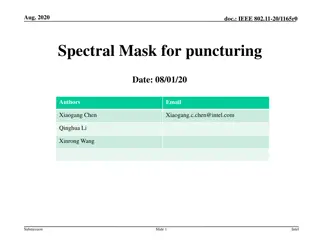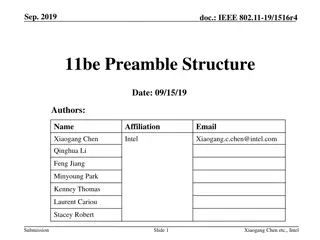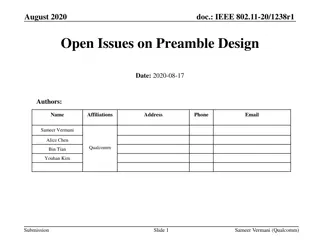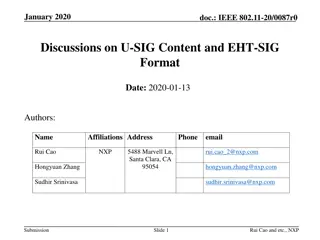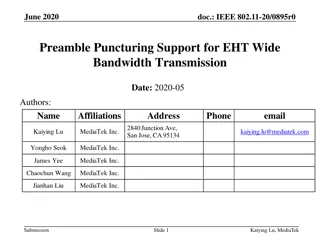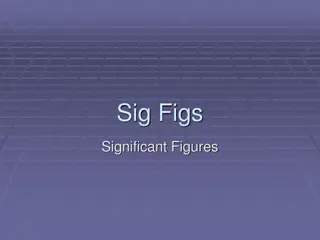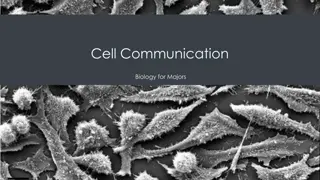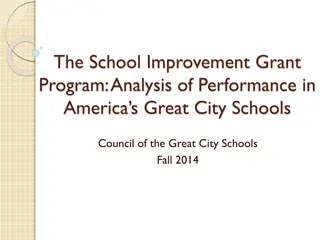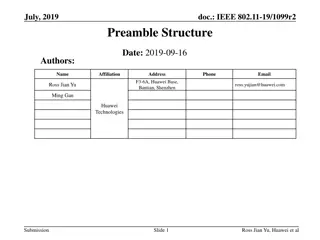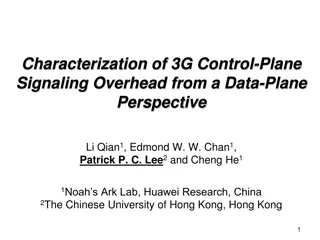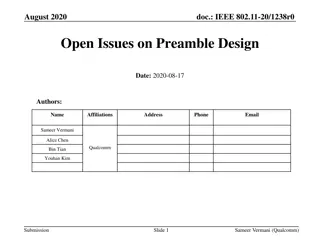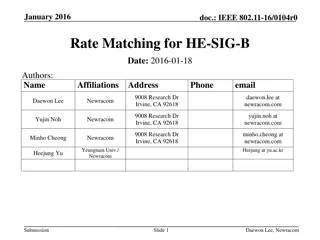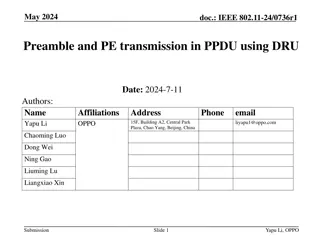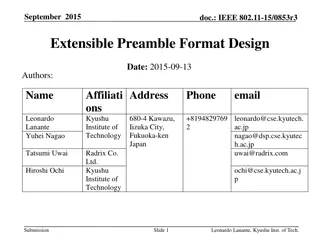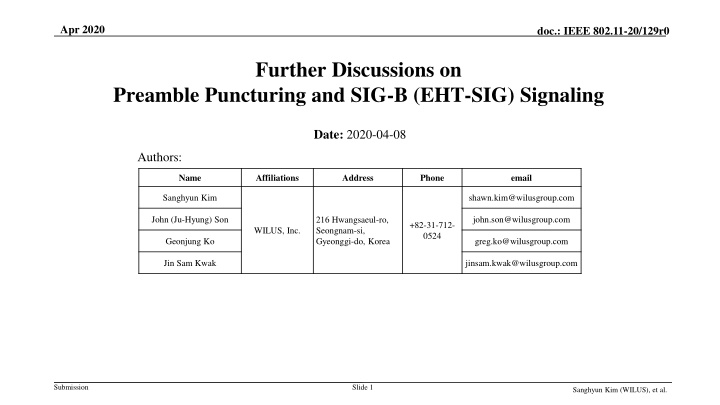
Enhanced EHT-SIG Signaling for IEEE 802.11-20
Explore the advancements in Enhanced EHT-SIG signaling for IEEE 802.11-20, focusing on puncturing performance and different EHT-SIG structures. Considerations for non-primary segments and methods for ensuring preamble signaling reception are discussed, providing valuable insights for efficient utilization of bandwidth in dense environments.
Download Presentation

Please find below an Image/Link to download the presentation.
The content on the website is provided AS IS for your information and personal use only. It may not be sold, licensed, or shared on other websites without obtaining consent from the author. If you encounter any issues during the download, it is possible that the publisher has removed the file from their server.
You are allowed to download the files provided on this website for personal or commercial use, subject to the condition that they are used lawfully. All files are the property of their respective owners.
The content on the website is provided AS IS for your information and personal use only. It may not be sold, licensed, or shared on other websites without obtaining consent from the author.
E N D
Presentation Transcript
Apr 2020 doc.: IEEE 802.11-20/129r0 Further Discussions on Preamble Puncturing and SIG-B (EHT-SIG) Signaling Date: 2020-04-08 Authors: Name Affiliations Address Phone email Sanghyun Kim shawn.kim@wilusgroup.com John (Ju-Hyung) Son john.son@wilusgroup.com 216 Hwangsaeul-ro, Seongnam-si, Gyeonggi-do, Korea +82-31-712- 0524 WILUS, Inc. Geonjung Ko greg.ko@wilusgroup.com Jin Sam Kwak jinsam.kwak@wilusgroup.com Submission Slide 1 Sanghyun Kim (WILUS), et al.
Apr 2020 doc.: IEEE 802.11-20/129r0 Introduction EHT supports wider bandwidth operation EHT includes support for 320 MHz bandwidth [1] However, it is hard to expect the whole 320 MHz channel to be idle in dense environments EHT needs to enhance the utilization of non-contiguous channel access method [2][3] In our previous contribution [4], we evaluated the performance of the various content channel structures in terms of puncturing flexibility Recently, [5][6] introduced different EHT-SIG information per 80/160 MHz In this contribution, we further evaluate puncturing performances along with the different EHT-SIG per 80 MHz segment We evaluate two EHT-SIG signaling methods for STAs parked in non-primary segments, and analyze puncturing performances Submission Slide 2 Sanghyun Kim (WILUS), et al.
Apr 2020 doc.: IEEE 802.11-20/129r0 Two EHT-SIG content channels per 80 MHz segment [5][7] proposed the preamble design that allows different signaling information conveyed on different 80 MHz segment This contribution considers the followings as a starting point for discussion EHT-SIG per 80 MHz segment conveys different contents EHT-SIG per 80 MHz segment has two content channels similar to HE-SIG-B 1 2 1 2 3 4 3 4 5 6 5 6 7 8 7 8 80 MHz Segment #1 (P80) 80 MHz Segment #4 80 MHz Segment #2 Content channel structure of 320 MHz PPDU 80 MHz Segment #3 Receiving two EHT-SIG content channels in non-P80 segment 11be STA parked in a non-P80 segment has no dedicated P20 channel to receive puncturing information, therefore the locations of non-punctured content channels are unknown to the STA Submission Slide 3 Sanghyun Kim (WILUS), et al.
Apr 2020 doc.: IEEE 802.11-20/129r0 Considerations on the signaling of non-primary segment There may be two methods to ensure preamble signaling reception for the STAs parked in non-P80 segments Method 1) Set virtual P20 for each non-P80 segments STAs parked in a non-P80 segment decode U-SIG in the virtual P20 Similar complexity to 11ax on the STA-side A virtual P20 channel cannot be punctured when its non-P80 segment has non-punctured channels If a virtual P20 channel is punctured, its non-P80 segment is also punctured Method 2) Parallel decoding of four 20 MHz sub-channels STAs parked in a non-P80 segment decode all four 20 MHz sub-channels to detect non-punctured sub-channels of the segment It requires improved processing capability to 11be STAs compared to 11ax STAs Submission Slide 4 Sanghyun Kim (WILUS), et al.
Apr 2020 doc.: IEEE 802.11-20/129r0 Available puncturing patterns per 80 MHz segment (Virtual) P20 Busy Method 1: Set virtual P20 for each non-P80 segments Available puncturing patterns per segment are the same with 11ax P80 s puncturing patterns (Virtual) P20 Busy (Virtual) P20 Busy Busy (Virtual) P20 Busy Available puncturing patterns of Method 1 (per segment) Method 2: Parallel decoding of four 20 MHz sub-channels More flexible puncturing patterns are available if two different content channels are present within the segment Idle or Busy Busy Idle Assumption 1. Content channel structure per segment is similar to 11ax (1, 2, 1, 2) Assumption 2. Puncturing patterns per 80 MHz segment are individually determined -Even if only P20 is IDLE within P80 channel, non-P80 segment can utilize preamble puncturing Available puncturing patterns of Method 2 (per segment) Submission Slide 5 Sanghyun Kim (WILUS), et al.
Apr 2020 doc.: IEEE 802.11-20/129r0 Simulation results Throughput results of method 1 and method 2 compared with 11ax design Simulation setup in appendix +6.5 % TPUT Baseline performance -2.5 % TPUT 499.67 Throughput (Mbps) 468.27 457.4 -1.5 % TPUT -20 % TPUT 181.8 178.98 157.25 11AX CONTENT CHANNEL DESIGN (1, 2, 1, 2) METHOD 1 (SET VIRTUAL P20) METHOD 2 (DECODE 80 MHZ) OBSS Load: 10 Mbps OBSS Load: 50 Mbps Method 1 shows lower TPUT performance than 11ax design For the heavy loaded OBSS case, the method 1 s virtual P20 limitation incurs 20 % lower TPUT performance than 11ax design Method 2 increases TPUT performance in the light loaded OBSS case However, for the heavy loaded OBSS cases, the method 2 also shows slight performance drop than 11ax design Submission Slide 6 Sanghyun Kim (WILUS), et al.
Apr 2020 doc.: IEEE 802.11-20/129r0 Performance Analysis Method 1 and 2 have difficulty in utilizing non- P80 segments due to limited puncturing patterns Non-primary 80 MHz channel status rarely matches the available puncturing patterns For the P80 segment, one of two content channels is always present in the P20, but non-P80 segments have no dedicated channel to receive one of the two content channels 100 Channel occupancy (%) 80 60 40 20 0 1 (P20) 2 3 4 5 6 7 8 9 10 11 12 13 14 15 16 Sub-channel index OBSS Load: 10 Mbps 60 11ax content channel design (1, 2, 1, 2) Channel occupancy (%) 50 METHOD 1 (Set Virtual P20) 40 METHOD 2 (Decode 80 MHz) STAs parked in non-P80 segment are relatively hard to be served For the different EHT-SIG per 160 MHz, a similar phenomenon may occur at the secondary 160 MHz 30 20 10 0 1 (P20) 2 3 4 5 6 7 8 9 10 11 12 13 14 15 16 Sub-channel index OBSS Load: 50 Mbps We need to consider ways to improve the signaling success probability on the non-primary segments Non-P80 segments have no P20-like channel that never punctured Never punctured Idle VP 20 VP 20 VP 20 P20 Busy Idle or Busy non-P80#2 non-P80#1 non-P80#3 P80 Submission Slide 7 Sanghyun Kim (WILUS), et al.
Apr 2020 doc.: IEEE 802.11-20/129r0 Necessities of improving content channel structure Signaling success probability is highly dependent on the content channel structure Our previous contribution concluded that two-content channel structure has good balance in terms of channel accessibility and signaling overhead, and single-content channel structure has the best channel accessibility (puncturing flexibility) [4] 11ax-like two-content channel structure may not be the best structure for EHT-SIG of the non-primary segment Different channel accessibility of each segments can cause fairness issue between STAs parked in the primary segment and STAs parked in non-primary segments We need to consider new content channel structures to enhance signaling success probability to improve puncturing flexibility Submission Slide 8 Sanghyun Kim (WILUS), et al.
Apr 2020 doc.: IEEE 802.11-20/129r0 Summary We showed two signaling methods for the non-primary segments and analyzed puncturing flexibility of the two methods incorporating different EHT-SIG per 80 MHz segments Signaling failure on the non-P80 segments degrades puncturing flexibility and causes fairness issue between STAs parked in the P80 segment and the non-P80 segments We propose to further study new content channel structures of EHT-SIG Submission Slide 9 Sanghyun Kim (WILUS), et al.
Apr 2020 doc.: IEEE 802.11-20/129r0 Straw Poll 1 Which option do you prefer for preamble decoding in the non-primary segment? Opt. 1 : Set virtual P20 for each non-P80 segments A virtual P20 channel cannot be punctured when its non-P80 segment has non-punctured channels Opt. 2 : Parallel decoding of four 20 MHz sub-channels STAs parked in a non-P80 segment decode all four 20 MHz sub-channels to detect non-punctured sub-channels of the segment Submission Slide 10 Sanghyun Kim (WILUS), et al.
Apr 2020 doc.: IEEE 802.11-20/129r0 References [1] 11-19-1262-08-00be-specificication-framework-for-tgbe [2] 11-19-1242-00-00be-wider-bandwidth-channel-access-in-eht [3] 11-19-1190-00-00be-improved-preamble-puncturing-in-802-11be [4] 11-19-1606-00-00be-preamble-puncturing-and-sig-b-signaling [5] 11-20-0439-00-00be-efficient-eht-preamble-design [6] 11-20-0020-02-00be-consideration-for-eht-sig-transmission [7] 11-20-0380-00-00be-u-sig-structure-and-preamble-processing Submission Slide 11 Sanghyun Kim (WILUS), et al.
Apr 2020 doc.: IEEE 802.11-20/129r0 Appendix: Simulation Setup Investigate performances of different preamble puncturing options in OBSS environments EHT BSS 1 BSS operating BW: 320MHz 1AP-1STA, DL only, full buffer MCS 7 fixed, A-MPDU (10 MPDUs per non-punctured 20 MHz), 1 MPDU=1500 Bytes PPDU BW: P20, P40, P80, P160, P320, and preamble puncturing BW based on its CCA results and the method 1/2 Assume EHT-SIG field overhead of 4 symbols (16 us) required per 20MHz in PPDU BW OBSS Among 320MHz channels, 3 OBSSs exist per each 80MHz segment Each OBSS operating BW: 80MHz / 40MHz / 20MHz each Primary channel is randomly chosen within each 80MHz segment PPDU BW: P20, P40, or P80 based on CCA results (no puncturing) Each OBSS has 1AP-1STA, DL only, CBR 10Mbps or CBR 50Mbps MCS 7 fixed, A-MPDU (Max 64 MPDUs), 1 MPDU=1500 Bytes Submission Slide 12 Sanghyun Kim (WILUS), et al.
Apr 2020 doc.: IEEE 802.11-20/129r0 Appendix: Simulation Setup (OBSS example) Fixed P20 location EHT BSS (320 MHz) P20 OBSS 1 (80 MHz) 801 802 803 804 OBSS 2 (40 MHz) 401 402 403 404 OBSS 3 (20 MHz) 201 202 203 204 80 MHz 320 MHz 3 OBSS per 80MHz segment random P20 location for each OBSS Submission Slide 13 Sanghyun Kim (WILUS), et al.



